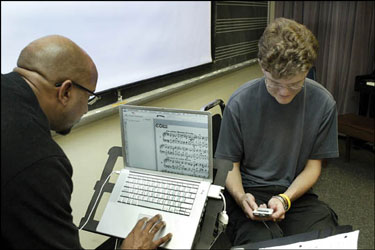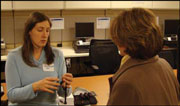Yvonne Belanger

Photo by Duke University Photography
Since its founding in January 1999, CIT has increased innovation in University classrooms by providing training and project assistance to over 1000 Duke faculty, responding to thousands of inquiries, awarding over 170 grants and playing a leading role in several major university initiatives.
The Center for Instructional Technology (CIT) and the Duke Libraries have much to celebrate about the Center’s first ten years. Since its founding in January 1999, CIT has increased innovation in University classrooms by providing training and project assistance to over 1000 Duke faculty, responding to thousands of inquiries, awarding over 170 grants and playing a leading role in several major University initiatives. CIT’s reach has also extended beyond the Duke community through publications, presentations and collaborations that have raised the University’s profile and enabled other institutions to benefit from innovation and lessons learned by faculty at Duke.

Photo by Duke University Photography
CIT Director Lynne O’Brien at the CIT Showcase in 2004. This annual event draws hundreds of faculty and staff from Duke and other local universities.
Duke established the Center for Instructional Technology (CIT) in response to one of a number of recommendations made under a “Strategic Plan for Information Technology in Teaching and Learning.” CIT’s founding director Lynne O’Brien came to Duke from Brown University where she was a member of the faculty and manager of instructional computing services. O’Brien’s experience as a faculty member has given her significant insight into the best ways to connect with Duke faculty while building strong relationships to clearly articulate and advocate for their needs with the University’s senior leadership.
Over the past decade, CIT has worked collaboratively with partners in departments and schools across Duke to provide faculty with the tools and services that would enable them to harness the potential of the latest technological applications for teaching and learning. “CIT was an invaluable resource and collaborative partner in the effort to promote the effective use of instructional technology inside and outside of the classroom,” reflected Robert Thompson, professor of psychology and neuroscience who served as dean of Trinity College from 1999-2008. Long-time CIT Advisory Board member and Distinguished University Service Professor Len Spicer said, “Through the seed money that [CIT] put into a number of initiatives, excitement and energy is conveyed from faculty to faculty…from one classroom to another and one discipline to another. There’s no doubt that CIT and its programs have increased technology awareness and perspectives of how technology can be used effectively in classrooms across campus.”
The First Step: From Chalkboard to Blackboard and Beyond
One of CIT’s first challenges was to provide faculty with an easier way to create course web pages. The solution was the system now known as Blackboard, which CIT implemented in partnership with Arts & Sciences Computing and the Office of Information Technology. From fewer than 150 course web sites in the first semester, Duke’s Blackboard system has expanded to include a majority of undergraduate courses, with over 3200 active course sites every year. “I think CIT has made a big difference for undergraduate education and has improved the classroom experience immensely by helping faculty move from home-grown systems into the common platform of Blackboard,” said CIT Advisory Board member Spicer. While many faculty use Blackboard to create and manage course web sites with little or no assistance, for those who do need help or want ideas, CIT offers a range of options to accommodate faculty needs, including online tutorials, custom workshops and even personal office visits.
As the types of technology used in the classroom have changed, so have the ways that Blackboard is used to support teaching and learning. In the beginning, faculty used it primarily to share their syllabi, post announcements and send email messages to students. Now, many faculty routinely also use Blackboard to collect electronic assignments, offer students self-graded practice quizzes, share lecture recordings, and provide a space for student-student and faculty-student interaction through the use of blogs and wikis. Blackboard course sites often give students access to rich multimedia course materials such as images, audio and video as well as library resources such as electronic course reserves. In the spring 2008 semester, all Blackboard course sites were enhanced with Wimba Voice tools, enabling faculty and students to capture and share audio recordings directly within their course websites.
Working with campus partners to support Blackboard and assist faculty in using this tool is only one segment of CIT’s activities. From its beginning, CIT has put considerable emphasis on increasing awareness among faculty of the broad range of instructional tools and encouraging faculty to think creatively about how to use them to address teaching challenges and achieve their goals in the classroom. Each year CIT sponsors dozens of workshops and other events where faculty can learn about these tools from CIT staff and colleagues who have tried them. The CIT programming culminates annually with an instructional technology showcase that attracts hundreds of faculty and staff eager to share their success, inspire their colleagues and learn from peers.
The Rise of Multimedia and Collaboration
Audio and video have both played important roles in the classroom for decades, but the cassettes and VCRs prevalent in the late 1990s have all but disappeared from Duke classrooms. Addressing needs articulated by faculty for better ways to share multimedia via the Web, CIT launched a streaming media server pilot in the spring of 2001; this pilot evolved into a robust service that is now managed by the University’s Office of Instructional Technology. Duke students and faculty have come to rely on streaming media as well as an array of other tools for creating and sharing multimedia course content.

CIT staff distributed iPods
to all first-year students in 2004.
The University’s 2004 iPod project, which led to the current Duke Digital Initiative, greatly increased faculty use of audio and video and heightened their awareness of the ways in which creating and collaborating with rich media could enhance learning. Digitized images, audio, and video have become common teaching tools in Duke courses. Laptops and multimedia wireless mobile devices give students and faculty access to audio and video from virtually anywhere. Students are no longer passive consumers of multimedia; in many courses they also employ audio and video to capture content, share, and collaborate. iPods, web-based audio recording tools, and, most recently, tiny Flip cameras are used in nearly every discipline. Lab facilities are still in high demand for class meetings and high-end computing, but individual students no longer need to go to labs to complete homework assignments requiring audio and video recording. Music and film enrich an array of courses. Audio and video production are also common activities in courses such as second language learning, writing-intensive courses where students and faculty frequently exchange recordings of feedback, and the many courses where students conduct interviews and gather field notes.
Vicki Russell has embraced these web-based devices and other new tools. As director of the Writing Studio and a faculty member, Russell has worked with CIT on a range of projects to support her classroom teaching and enhance the services offered by the Writing Studio. “I find myself intrigued and energized by the myriad of possibilities available—from Blackboard and Wimba, to iPods, Flip videos, and most recently virtual worlds,” said Russell. “I appreciate the opportunities CIT provides me for training, support, and networking, as well as grant support for innovative projects. I particularly admire the overall attitude CIT has towards technology—that it is not the El Dorado but does offer tools for measured and thoughtful ways to achieve certain learning objectives.”
Innovator, Matchmaker, Navigator

Faculty consider strategies for maximizing new learning environments during a May 2008 CIT workshop.

Lisa Croucher from Duke’s Global Health Institute examines an Amazon Kindle e-book reader, part of CIT’s exploratory equipment pool.

CIT assistant director Amy Campbell demonstrates a web camera available through the Duke Digital Initiative to a faculty member in the CIT lab.

Ingeborg Walther (German) and Daniel Foster (Theater Studies) participated in CIT’s 2004-05 Instructional Technology Fellows program. With support from the program, Walther and Foster enhanced their courses with multimedia.

Chemistry librarian Anne Langely presents a joint CIT-library study of e-book reader technology entitled, “An iPod for Books?” at the CIT Showcase.
The Center for Instructional Technology uses a variety of strategies to support teaching and learning and promote innovation. Some projects receive financial aid, but most of the Center’s assistance takes the form of consulting, advising in course planning, and helping faculty navigate the network of campus resources and services to find the tool or service that best meets their needs. The CIT staff also provides guidance to faculty interested in web-based technologies such as Flickr, YouTube, or Google Earth, showing them how these freely available tools can be used effectively in the classroom.
In addition to funding innovative projects and faculty development, the Center operates a lab where instructors have access to a range of technologies that might not be available in their home departments. The CIT Instructional Technology Lab, opened in the fall of 2000, provides tools and support for digitizing text, audio and video as well as an inventory of equipment that faculty can take out on short-term loans to “play” with. Examples of equipment currently available for exploration include GPS devices for combining geospatial data with images to create visualizations and a 3D SpaceNavigator for interacting with three-dimensional virtual environments. By experimenting with the Lab’s equipment, faculty learn whether or not the devices have any potential for use in the classroom. The Lab, located in the Bostock building of the Perkins Library complex, is also a venue for workshops, training and consulting.
The Center also spreads innovation by connecting faculty across departments and schools when they share the same challenges. Providing opportunities for faculty to learn from one another and encourage each other to try new ideas and tools has proven to be one of CIT’s most effective strategies for disseminating innovation. Faculty gather to share tips and strategies on teaching with tablet PCs or meet for lunch to discuss effective methods for online teaching.
The Center’s support for different faculty communities has ranged from assisting with logistics and identifying common interests to giving faculty stipends for more formal long-term efforts. An example of these long-term faculty collaborations can be found in one of CIT’s most popular and successful initiatives, the Instructional Technology Fellows program. Since the inception of the Fellows program in 2002, seventy-five faculty have participated. Fellows work together in one of several ways: as a cohort for anywhere between a semester and an entire academic year on individual projects; in a series of sessions clustered around a theme; or as a group within a discipline working together on a joint project. In 2008-09 CIT has supported two separate groups of faculty fellows—one focused on teaching in flexible learning spaces and another on integrating student video production projects into their courses.
CIT Collaborations with Library Colleagues
Making the Center for Instructional Technology a department within the Duke University Libraries has contributed to the Center’s effectiveness. As technology has become a more integral part of the academic life of Duke’s faculty and students, CIT’s academic consultants and librarians have found increasing opportunities for collaboration. “The campus-wide process that led to creation of CIT was a recognition and validation of the role that the library plays in the technological life of the campus, “said David Ferriero, university librarian at the time of CIT’s founding. In recent years, librarians and CIT consultants have frequently worked together to explore the implications of new hardware and software tools for the classroom and the library. CIT academic technology consultants and librarians have investigated the ways in which the mobile devices many students and faculty bring to campus could provide access to library resources and services. Using a Sony e-Reader from CIT’s lab, librarians and CIT shared ideas about how students and faculty could use the new generation of e-book readers to view electronic text and other digitized materials. Exploratory equipment from CIT has also supported recent trials of roving reference services with iPhones and ultramobile PCs.
CIT staff and librarians also collaborate directly in their support of Duke courses. In Associate Professor Jen’nan Read’s Sociology 161, “Social Determinants of U.S. Health Disparities,” librarians Joel Herndon and Linda Daniel worked with CIT consultant Shawn Miller to provide students with technology training and library resources in support of student projects. Students in Professor Read’s course used a variety of technologies to successfully combine maps, census data and other research about Durham in their study of health disparities in the local community. Miller recalled, “When I first met with with [Dr. Read], she wanted to know about possible uses of census data and maps for her students’ projects—so I brought Joel [Herndon] into the conversation…Linda [Daniel] was already building a LibGuide for Jen’nan.” Miller’s experience using visualization tools was combined with Herndon’s data skills and Daniel’s subject expertise to provide broad-based support for the students’ projects. “I think this kind of synergy is really what we’re aiming for when we pull together different resources to make a project something much better than what we perhaps might have been able to do on our own,” said Miller.

Photo by Duke University Photography
…when I saw the facilities at the Link during my ‘new faculty’ orientation, I knew I wanted teach there. Little did I know that the technology and equipment would be equally matched by the exceptional quality and professionalism of the librarians and support teams at CIT. They introduced me to the technology and created outstanding presentations tailored specifically for each of my two courses …[and] created Library Guides for my Blackboard sites that were also uniquely tailored to meet my course needs. My experiences working with CIT have been terrific.
— Jen’nan Read, Associate Professor of Sociology and Global Health
Although CIT is based at Perkins Library, its services are not confined to the building. The staff travels around the campus, taking events to departments and visiting faculty offices to offer one-on-one consulting and training. CIT staff also gather groups of faculty in departments and schools to shape the development of new services and to evaluate existing ones. In recent years, these groups have provided feedback on everything from CIT grant offerings, tools offered by Blackboard, and the success of strategic projects such as the Duke Digital Initiative.
Partnerships Within and Beyond Duke

Assistant Professor of the Practice Jeffrey Forbes from Computer Science participates in a 2007 panel presentatation with colleagues from the Pratt School of Engineering, describing their year-long CIT fellowship to explore tablet PCs. “Just having people with similar interests come together to talk about pedagogy and instructional technology is extremely valuable,” commented Forbes.
The growth of CIT’s programs and impact has been fueled not only by library connections but also the Center’s involvement in University initiatives and partnerships across campus. When a library endowment offered an opportunity to strengthen partnerships with local schools, CIT’s strength in both pedagogy and outreach made the Center the ideal home for the new PepsiCo K-12 Technology Mentor Coordinator. The Foreign Language Technology Services group in Arts & Sciences, established separately from CIT, ultimately joined with the Center and now functions as its Instructional Media and Language Technology Services group. This merger has resulted in better interdisciplinary connections and the ability to share staff and resources across the language labs and CIT lab. The success over the past four years of the Duke Digital Initiative has also resulted from productive collaborations between CIT and other Duke staff as well as external partners such as Apple and other vendors. These programs, in turn, have shaped the direction and growth of CIT.
CIT has also enjoyed a long and fruitful partnership with the School of Medicine’s Clinical Research Training Program (CRTP). Through synchronous interactive videoconferencing, CRTP delivers courses simultaneously to learners at Duke and at the National Institutes of Health headquarters in Bethesda, Maryland. Over the past five years CRTP and the Center for Instructional Technology have pooled resources to fund joint positions that support the shared needs of both groups in instructional design and program evaluation. “The success enjoyed by the CRTP over the last decade…would not have been possible without our incredibly productive relationships…with the director and staff of Duke’s Center for Instructional Technology,” said William Wilkinson, executive director of CRTP.
The Road Ahead
As the Center for Instructional Technology enters its second decade, it continues to support the academic mission of Duke University by helping instructors find innovative ways to use technology to achieve their teaching goals. Exciting developments in multimedia, mobile devices, and the next generation web of visualization and collaboration tools will present plenty of new opportunities in coming years for CIT and the faculty they support. University Librarian Deborah Jakubs said, “The Libraries value the opportunity to further innovation in teaching and learning through CIT’s diverse initiatives that advance Duke’s technological capacity.”
 Yvonne Belanger is the head of program evaluation for the Center for Instructional Technology
Yvonne Belanger is the head of program evaluation for the Center for Instructional Technology

